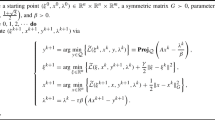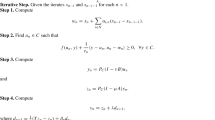Abstract
This paper considers the regularization continuation method and the trust-region updating strategy for the nonlinearly equality-constrained optimization problem. Namely, it uses the inverse of the regularization quasi-Newton matrix as the pre-conditioner and the Sherman–Morrison–Woodbury formula to improve its computational efficiency in the well-posed phase, and it adopts the inverse of the regularization two-sided projection of the Hessian as the pre-conditioner to improve its robustness in the ill-conditioned phase. Since it only solves a linear system of equations and the Sherman–Morrison–Woodbury formula significantly saves the computational time at every iteration, and the sequential quadratic programming (SQP) method needs to solve a quadratic programming subproblem at every iteration, it is faster than SQP. Numerical results also show that it is more robust and faster than SQP (the built-in subroutine fmincon.m of the MATLAB2020a environment and the subroutine SNOPT executed in GAMS v28.2 (GAMS Corporation, 2019) environment). The computational time of the new method is about one third of that of fmincon.m for the large-scale problem. Finally, the global convergence analysis of the new method is also given.



Similar content being viewed by others
Data Availability Statement
If it is requested, we will provide the test data.
Code Availability
If it is requested, we will provide the code.
References
Andrei, N.: An unconstrained optimization test functions collection. Adv. Model Optim. 10, 147–161 (2008)
Adorio, E.P., Diliman, U.P.: MVF—Multivariate test functions library in C for unconstrained global optimization, http://www.geocities.ws/eadorio/mvf.pdf (2005)
Allgower, E.L., Georg, K.: Introduction to Numerical Continuation Methods. SIAM, Philadelphia (2003)
Ascher, U.M., Petzold, L.R.: Computer Methods for Ordinary Differential Equations and Differential-Algebraic Equations. SIAM, Philadelphia (1998)
Boggs, P.T., Tolle, J.W.: Sequential quadratic programming. Acta Numer. 4, 1–51 (1995)
Broyden, C.G.: The convergence of a class of double-rank minimization algorithms. J. Inst. Math. Appl. 6, 76–90 (1970)
Brown, A.A., Bartholomew-Biggs, M.C.: ODE versus SQP methods for constrained optimization. J. Optim. Theory Appl. 62, 371–386 (1989)
Brenan, K.E., Campbell, S.L., Petzold, L.R.: Numerical Solution of Initial-Value Problems in Differential-Algebraic Equations. SIAM, Philadelphia (1996)
Bioucas-Dias, J.M., Figueiredo, M.A.T.: Alternating direction algorithms for constrained sparse regression: application to hyperspectral unmixing. In: 2010 2nd Workshop on Hyperspectral Image and Signal Processing: Evolution in Remote Sensing, 1–4, http://doi.org/10.1109/WHISPERS.2010.5594963 (2010)
Butcher, J.C., Jackiewicz, Z.: Construction of high order diagonally implicit multistage integration methods for ordinary differential equations. Appl. Numer. Math. 27, 1–12 (1998)
Byrd, R., Nocedal, J., Yuan, Y.X.: Global convergence of a class of quasi-Newton methods on convex problems. SIAM J. Numer. Anal. 24, 1171–1189 (1987)
Caballero, F., Merino, L., Ferruz, J., Ollero, A.: Vision-based odometry and SLAM for medium and high altitude flying UAVs. J. Intell. Robot. Syst. 54, 137–161 (2009)
Coffey, T.S., Kelley, C.T., Keyes, D.E.: Pseudotransient continuation and differential-algebraic equations. SIAM J. Sci. Comput. 25, 553–569 (2003)
Conn, A.R., Gould, N., Toint, Ph.L.: Trust-Region Methods. SIAM, Philadelphia (2000)
Chu, M.T., Lin, M.M.: Dynamical system characterization of the central path and its variants-a revisit. SIAM J. Appl. Dyn. Syst. 10, 887–905 (2011)
d’Aspremont, A., El Ghaoui, L., Jordan, M., Lanckriet, G.R.: A direct formulation for sparse PCA using semidefinite programming. SIAM Rev. 49, 434–448 (2007)
Dolan, E.D., Moré, J.J.: Benchmarking optimization software with performance profiles. Math. Program 91, 201–213 (2002)
Edelman, A., Arias, T.A., Smith, S.T.: The geometry of algorithms with orthogonality constraints. SIAM J. Matrix Anal. Appl. 20, 303–353 (1999)
Fiacco, A.V., McCormick, G.P.: Nonlinear Programming: Sequential Unconstrained Minimization Techniques, SIAM (1990)
Fletcher, R.: A new approach to variable metric algorithms. Comput J 13, 317–322 (1970)
Fletcher, R., Powell, M.J.D.: A rapidly convergent descent method for minimization. Comput J 6, 163–168 (1963)
Fadili, J.M., Starck, J.L.: Monotone operator splitting for optimization problems in sparse recovery. In: IEEE ICIP, Cairo, Egypt, pp. 1461–1464, http://doi.org/10.1109/ICIP.2009.5414555 (2009)
Figueiredo, M.A.T., Bioucas-Dias, J.M.: Restoration of Poissonian images using alternating direction optimization. IEEE Trans. Image Process. 19, 3133–3145 (2010)
Forero, P.A., Cano, A., Giannakis, G.B.: Consensus-based distributed support vector machines. J. Mach. Learn. Res. 11, 1663–1707 (2010)
GAMS v28.2, GAMS Corporation, https://www.gams.com/ (2019)
Goh, B.S.: Approximate greatest descent methods for optimization with equality constraints. J. Optim. Theory Appl. 148, 505–527 (2011)
Goldfarb, D.: A family of variable metric updates derived by variational means. Math. Comput. 24, 23–26 (1970)
Gould, N.I.M., Orban, D., Toint, Ph.L.: CUTEst: a constrained and unconstrained testing environment with safe threads for mathematical optimization. Comput. Optim. Appl. 60, 545–557 (2015)
Golub, G.H., Van Loan, C.F.: Matrix Computations, 4th edn. The Johns Hopkins University Press, Baltimore (2013)
Gill, P.E., Murray, W., Wright, M.H.: Practical Optimization. Academic Press, London (1981)
Gill, P.E., Murray, W., Saunders, M.A.: SNOPT: an SQP algorithm for large-scale constrained optimization. SIAM Rev. 47, 99–131 (2005)
Gill, P.E., Murray, W., Saunders, M.A.: User’s guide for SQOPT Version 7: software for large-scale linear and quadratic programming (2006)
Han, S.P.: A globally convergent method for nonlinear programming. J. Optim. Theory Appl. 22, 297–307 (1977)
Hansen, P.C.: Regularization tools: a MATLAB package for analysis and solution of discrete ill-posed problems. Numer Algorithms 6, 1–35 (1994)
Helmke, U., Moore, J.B.: Optimization and Dynamical Systems, 2nd edn. Springer, London (1996)
Higham, D.J.: Trust region algorithms and timestep selection. SIAM J. Numer. Anal. 37, 194–210 (1999)
Hock, W., Schittkowski, K.: A comparative performance evaluation of 27 nonlinear programming codes. Computing 30, 335–358 https://doi.org/10.1007/BF02242139 (1983)
Jackiewicz, Z., Tracogna, S.: A general class of two-step Runge–Kutta methods for ordinary differential equations. SIAM J. Numer. Anal. 32, 1390–1427 (1995)
Kelley, C.T., Liao, L.-Z., Qi, L., Chu, M.T., Reese, J.P., Winton, C.: Projected pseudotransient continuation. SIAM J. Numer. Anal. 46, 3071–3083 (2008)
Lee, J.H., Jung, Y.M., Yuan, Y.X., Yun, S.: A subsapce SQP method for equality constrained optimization. Comput. Optim. Appl. 74, 177–194 (2019)
Lukšan, L.: Inexact trust region method for large sparse systems of nonlinear equations. J. Optim. Theory Appl. 81, 569–590 (1994)
Levenberg, K.: A method for the solution of certain problems in least squares. Q. Appl. Math. 2, 164–168 (1944)
Liao, L.-Z., Qi, H.D., Qi, L.Q.: Neurodynamical optimization. J. Glob. Optim. 28, 175–195 (2004)
Liu, X.-W., Yuan, Y.-Y.: A sequential quadratic programming method without a penalty function or a filter for nonlinear equality constrained optimization. SIAM J. Optim. 21, 545–571 (2011)
Lu, Z.S., Pong, K.K., Zhang, Y.: An alternating direction method for finding Dantzig selectors. Comput. Stat. Data Anal. 56, 4037–4046, https://doi.org/10.1016/j.csda.2012.04.019 (2012)
Luo, X.-L.: Singly diagonally implicit Runge–Kutta methods combining line search techniques for unconstrained optimization. J. Comput. Math. 23, 153–164 (2005)
Luo, X.-L., Liao, L.-Z., Tam, H.-W.: Convergence analysis of the Levenberg–Marquardt method. Optim. Methds Softw. 22, 659–678 (2007)
Liu, S.-T., Luo, X.-L.: A method based on Rayleigh quotient gradient flow for extreme and interior eigenvalue problems. Linear Algebra Appl. 432, 1851–1863 (2010)
Luo, X.-L.: A dynamical method of DAEs for the smallest eigenvalue problem. J. Comput. Sci. 3, 113–119 (2012)
Luo, X.-L., Lin, J.-R., Wu, W.-L.: A prediction-correction dynamic method for large-scale generalized eigenvalue problems. Abstr Appl Anal (2013), Article ID 845459, 1–8, http://dx.doi.org/10.1155/2013/845459
Luo, X.-L., Lv, J.-H., Sun, G.: Continuation methods with the trusty time-stepping scheme for linearly constrained optimization with noisy data. Optim. Eng. 23, 329–360, https://doi.org/10.1007/s11081-020-09590-z (2022)
Luo, X.-L., Xiao, H., Lv, J.-H.: Continuation Newton methods with the residual trust-region time-stepping scheme for nonlinear equations. Numer Algorithms 89, 223–247, https://doi.org/10.1007/s11075-021-01112-x (2022)
Luo, X.-L., Yao, Y.-Y.: Primal-dual path-following methods and the trust-region updating strategy for linear programming with noisy data. J. Comput. Math. 40, 760–780, https://doi.org/10.4208/jcm.2101-m2020-0173 (2022)
Luo, X.-L., Xiao, H., Lv, J.-H., Zhang, S.: Explicit pseudo-transient continuation and the trust-region updating strategy for unconstrained optimization. Appl. Numer. Math. 165, 290–302, https://doi.org/10.1016/j.apnum.2021.02.019 (2021)
Luo, X.-L., Xiao, H.: Generalized continuation Newton methods and the trust-region updating strategy for the underdetermined system. J. Sci. Comput. 88, article 56, pp. 1–22. https://doi.org/10.1007/s10915-021-01566-0 (2021)
Luo, X.-L., Xiao, H.: The regularization continuation method with an adaptive time step control for linearly constrained optimization problems. Appl. Numer. Math. 181, 255–276, published online at https://doi.org/10.1016/j.apnum.2022.06.008 (2022)
Luo, X.-L., Xiao, H., Zhang, S.: Continuation Newton methods with deflation techniques for global optimization problems, arXiv preprint available at http://arxiv.org/abs/2107.13864, or Research Square preprint available at https://doi.org/10.21203/rs.3.rs-1102775/v1, July 30, 2021. Software available at https://teacher.bupt.edu.cn/luoxinlong/zh_CN/zzcg/41406/list/index.htm
Luo, X.-L., Zhang, S., Xiao, H.: Residual regularization path-following methods for linear complementarity problems, arXiv preprint available at http://arxiv.org/abs/2205.10727, pp. 1–30 (2022)
Ng, M., Weiss, P. Yuan, X.-M.: Solving constrained total-variation image restoration and reconstruction problems via alternating direction methods. SIAM. J. Sci. Comput. 32, 2710–2736, https://doi.org/10.1137/090774823 (2010)
Mascarenhas, M.F.: The BFGS method with exact line searches fails for non-convex objective functions. Math. Program 99, 49–61 (2004)
Mak, M.-W.: Lecture notes of constrained optimization and support vector machines, http://www.eie.polyu.edu.hk/~mwmak/EIE6207/ContOpt-SVM-beamer.pdf (2019)
MATLAB v9.8.0 (R2020a), The MathWorks Inc., http://www.mathworks.com (2020)
Moré, J.J., Garbow, B.S., Hillstrom, K.E.: Testing unconstrained optimization software. ACM Trans. Math. Softw. 7, 17–41 (1981)
Marquardt, D.: An algorithm for least-squares estimation of nonlinear parameters. SIAM J. Appl. Math. 11, 431–441 (1963)
Maculan, N., Lavor, C.: A function to test methods applied to global minimization of potential energy of molecules. Numer. Algorithms 35, 287–300 (2004)
Moore, E.H.: On the reciprocal of the general algebraic matrix. Bull. New Ser. Am. Math. Soc. 26, 394–395 (1920)
Nocedal, J., Wright, S.J.: Numerical Optimization. Springer, Berlin (1999)
Osborne, M.J.: Mathematical methods for economic theory, https://mjo.osborne.economics.utoronto.ca/index.php/tutorial/index/1/mem (2016)
Pan, P.-Q.: New ODE methods for equality constrained optimization (2): algorithms. J. Comput. Math. 10, 129–146 (1992)
Penrose, R.A.: Generalized inverses for matrices. Math. Proc. Camb. Philos. Soc. 51, 406–413 (1955)
Powell, M.J.D.: Convergence properties of a class of minimization algorithms. In: Mangasarian, O.L., Meyer, R.R., Robinson, S.M. (eds.) Nonlinear Programming 2, pp. 1–27. Academic Press, New York (1975)
Powell, M.J.D.: A fast algorithm for nonlinearly constrained optimization calculations. In: Watson, G.A. (ed.) Numerical Analysis, pp. 144–157. Springer, Berlin (1978)
Powell, M.J.D.: The convergence of variable metric methods for nonlinearly constrained optimization calculations. In: Mangasarian, O.L., Meyer, R.R., Robinson, S.M. (eds.) Nonlinear Programming 3, pp. 27–63. Academic Press, New York (1978)
Schittkowski, K.: NLPQL: a fortran subroutine solving constrained nonlinear programming problems. Ann. Oper. Res. 5, 485–500, https://doi.org/10.1007/BF02739235 (1986)
Schropp, J.: A dynamical systems approach to constrained minimization. Numer. Funct. Anal. Optim. 21, 537–551 (2000)
Schropp, J.: One and multistep discretizations of index 2 differential algebraic systems and their use in optimization. J. Comput. Appl. Math. 150, 375–396 (2003)
Shampine, L.F., Gladwell, I., Thompson, S.: Solving ODEs with MATLAB. Cambridge University Press, Cambridge (2003)
Shanno, D.F.: Conditioning of quasi-Newton methods for function minimization. Math. Comput. 24, 647–656 (1970)
Steidl, G., Teuber, T.: Removing multiplicative noise by Douglas–Rachford splitting methods. J. Math. Imaging Vis. 36, 168–184 (2010)
Surjanovic, S., Bingham, D.: Virtual library of simulation experiments: Test functions and datasets, retrieved from http://www.sfu.ca/~ssurjano (2020)
Sun, W.Y., Yuan, Y.X.: Optimization Theory and Methods: Nonlinear Programming. Springer, New York (2006)
Tanabe, K.: A geometric method in nonlinear programming. J. Optim. Theory Appl. 30, 181–210 (1980)
Tikhonov, A.N.: The stability of inverse problems. Dokl Akad Nauk SSRR 39, 176–179 (1943)
Tikhonov, A.N., Arsenin, V.Y.: Solutions of Ill-Posed Problems. Wiley, New York (1977)
Vanderbei, R., Lin, K., Liu, H., Wang, L.: Revisiting compressed sensing: exploiting the efficiency of simplex and sparsification methods. Math. Prog. Comput. 8, 253–269, https://doi.org/10.1007/s12532-016-0105-y (2016)
Wen, Z.-W., Yin, W.-T.: A feasible method for optimization with orthogonality constraints. Math. Program 142, 397–434 (2013)
Wilson, R.B.: A Simplicial Method for Convex Programming, Ph.D. thesis, Harvard University (1963)
Witten, D.M., Tibshirani, R., Hastie, T.: A penalized matrix decomposition, with applications to sparse principal components and canonical correlation analysis. Biostatistics 10, 515–534 (2009)
Yamashita, H.: A differential equation approach to nonlinear programming. Math. Program 18, 155–168 (1980)
Yuan, Y.: Recent advances in trust region algorithms. Math. Program 151, 249–281 (2015)
Acknowledgements
The authors are grateful to two anonymous referees for their comments and suggestions which greatly improve the presentation of this paper.
Funding
This work was supported in part by Grants 61876199 and 62376036 from National Natural Science Foundation of China, Grant YBWL2011085 from Huawei Technologies Co., Ltd., and Grant YJCB2011003HI from the Innovation Research Program of Huawei Technologies Co., Ltd.
Author information
Authors and Affiliations
Corresponding author
Ethics declarations
Conflict of interest
Not applicable.
Ethical Approval
Not applicable.
Additional information
Publisher's Note
Springer Nature remains neutral with regard to jurisdictional claims in published maps and institutional affiliations.
Tables of Numerical Results
Tables of Numerical Results
See Tables 3, 4, 5, 6, 7 and 8.
Rights and permissions
Springer Nature or its licensor (e.g. a society or other partner) holds exclusive rights to this article under a publishing agreement with the author(s) or other rightsholder(s); author self-archiving of the accepted manuscript version of this article is solely governed by the terms of such publishing agreement and applicable law.
About this article
Cite this article
Luo, Xl., Xiao, H. & Zhang, S. The Regularization Continuation Method for Optimization Problems with Nonlinear Equality Constraints. J Sci Comput 99, 17 (2024). https://doi.org/10.1007/s10915-024-02476-7
Received:
Revised:
Accepted:
Published:
DOI: https://doi.org/10.1007/s10915-024-02476-7
Keywords
- Continuation method
- Preconditioned technique
- Trust-region method
- Regularization technique
- Quasi-Newton method
- Sherman–Morrison–Woodbury formula




